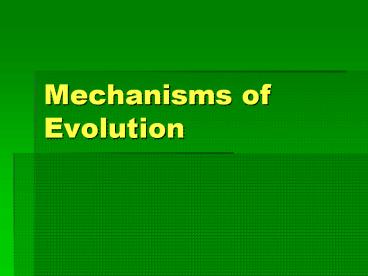Mechanisms of Evolution - PowerPoint PPT Presentation
Title:
Mechanisms of Evolution
Description:
Mechanisms of Evolution I. Natural Selection & Charles Darwin Charles Darwin (1819-1882) an English scientist considered the founder of the evolutionary theory ... – PowerPoint PPT presentation
Number of Views:323
Avg rating:3.0/5.0
Title: Mechanisms of Evolution
1
Mechanisms of Evolution
2
I. Natural Selection Charles Darwin
- Charles Darwin (1819-1882) an English scientist
considered the founder of the evolutionary theory - Evolution is often referred to as Darwinism
3
- Darwin studied many forms of life through the
voyage of the Beagle - Galapagos Islands was where Darwin studied a
majority of the organism
4
- Darwin's comparison of the animals of South
America and the Galapagos Islands caused him to
conclude that adaptation to the environment can
cause diversification, including origin of new
species
5
The Galapagos Islands
- Darwin notes
- Island species varied from the mainland species,
and from island-to-island - Each island had either long or short necked
tortoises depending on the island's vegetation
6
The Galapagos Islands
- Darwin noted
- Finches Bill shapes are adaptations to different
means of gathering food.
7
- Galapagos finch species varied by nesting site,
beak size, and eating habits
8
The Theory of Evolution Darwinism
- We have discussed the 4 supporting evidences of
evolution. - Comparative anatomy
- Molecular Biology
- Biogeography
- Embryology
Today we are going to discuss the 4 mechanisms of
HOW Evolution occurs
9
Outine 4 Mechanisms of Evolution
- Natural Selection
- Mutation
- Migration
- Genetic Drift
10
1 Natural Selection
- Natural Selection AKA Survival of the Fittest
- A gradual, non-random process by which biological
traits become either more or less common in a
population
As you can see there is a variation in the
phenotype of these beetles Green or brown
?
?
11
Genetic Variation Genetic differences within a
population.
The genetic variation in this scenario are the
genes that code for the color of the beetle.
12
3 Types of Natural Selection that Act on
Variation
- 1. Stabilizing natural selection that favors
average individuals
13
3 Types of Natural Selection that Act on
Variation
- 2. Directional selection natural selection
that favors an extreme form of a trait
14
3 Types of Natural Selection that Act on
Variation
- 3. Disruptive selection individuals w/ either
extreme form of a trait
15
2 Mutation
- Mutation change in a gene alteration of a
nucleotide sequence.
EX A mutation causes two green beetle parents to
have a brown beetle
16
3 Migration
- Migration Movement of some individuals to
another population
Gene Flow transfer of alleles from one
population to another population through
immigration of individuals . This disrupts allele
frequency.
17
4 Genetic Drift
- Genetic Drift some individuals may by chance and
not because of fitness leave more descendants
and therefore pass on their genes.
18
The Evolution of Species
- Species organisms that look alike can
interbreed to produce fertile offspring - Speciation evolution of a new species.
NOTE Organisms within the same species have
reproductive success ( ability to pass genes onto
the next generation in a way that they too can
pass on those genes.)
Mule
He can not have offspring because his parents are
two different species ?
Donkey
Horse
19
So how do new species come about?
20
Physical Barriers Cause Speciation
- 1. Geographic Isolation a physical barrier
divides a population
21
- 2. Reproductive Isolation the inability of
organisms to mate and breed fertile offspring - Genetic material becomes so different
fertilization can not occur - Behavior mating seasons are different
These Bowerbirds have different mating seasons
and rituals. These 2 factors contribute to
Reproductive Isolation
22
Does evolution happen fast or slow?
23
Both!
Speciation Rates - the time it takes for
evolution to occur. 2 Theories 1
Gradualism idea that species originate through
a gradual change of adaptations
24
- 2. Punctuated Equilibrium things staying the
same for a period of time then rapidly changing
due to a catastrophic event.
25
There are TWO types of Evolution
26
- 1 Divergent Evolution accumulation of
differences between groups which can lead to the
formation of new species
27
- 2 Convergent Evolution organisms not closely
relate, independently evolve similar traits (to
adapt to similar environments.)
28
Genetics Determines Evolution
- Gene Pool All the alleles in a populations
genes. In other words every form of a trait - Allelic Frequency the of any specific allele
w/in a gene pool
29
- Genetic Equilibrium allele frequency remains
the same over generations - Populations in genetic equilibrium are not
evolving - Factors that affects genes can affect equilibrium
- 1. Mutations negative, positive
- Negative more than likely causes death
- Positive may be beneficial
30
Trait Variations differences in Organisms
- Increases or decreases an organisms chance of
survival - Inherited and controlled by alleles
- Allelic frequencies in a populations gene pool
will change due to natural selection
31
(No Transcript)
32
- C. Patterns of Evolution
- 1. Adaptive Radiation ancestral species
evolves into an array of species to fit a
particular environment.































